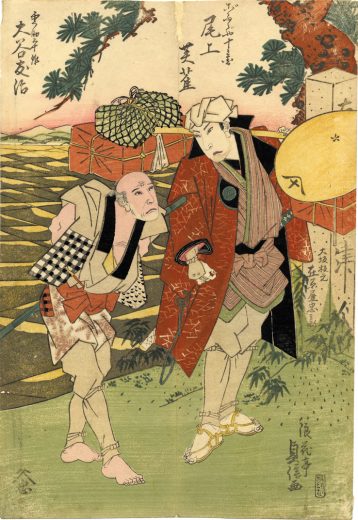Enjoy journeys in kabuki
May 30 (Tue), 2023 ‐August 27 (Sun), 2023
This museum exhibits ukiyo-e woodblock prints published in Osaka in the Edo period. Many of the ukiyo-e prints made in Osaka were portraits of kabuki actors performing on stage mainly around Dotombori area.
In the Edo period Dotombori was an entertainment quarter with a lot of people going to kabuki theatres, puppet theatres and cafes. In the latter half of the Edo period people started going to ‘Ise mairi’ (a pilgrimage to the Ise-jingu shrine) but for many ordinary people a journey was not yet at all affordable. Ukiyo-e woodblock prints and kabuki plays gave them simulated experience of a journey.
In this feature exhibition, we focus on journeys in kabuki plays. Please enjoy ukiyo-e prints that depict actors in travel outfit including in a kabuki play ‘Igagoe norikake kappa’ in which a son finds long-lost father in Numazu chapter.

Drawn by Sadanobu
‘Igagoe norikake kappa’
Actors;
Onoe Fujaku III (Playing Jubei the draper)
Otani Tomoji I(Playing Heisaku the coolie)
‘The revenge at Iga-Ueno’ and Iga-goe mono (crossing-Iga stories)
‘The revenge at Iga-Ueno’ is one of the three greatest revenge stories in kabuki and puppet plays. The real incident occured in Kan-ei 11 (1634), Araki Mataemon, very strong warrior, helped Watanabe Kazuma, his brother-in-law, to avenge Kawai Matagoro for his brother’s death. (The other two greatest revenge stories are ‘Revenge of Soga brothers’ and ‘Revenge of the Ako roshi).
‘Iga-goe norikake kappa’ was performed at a kabuki theatre in Osaka in An-ei 5 (1776), some 140 years after the revenge occurred. The time of the incident and names of characters were changed; in a play the time was set to Ashikaga era, the names Araki Mataemon, Watanabe Kazuma and Kawai Matagoro were changed to Karaki Masaemon, Wada Shizuma and Sawai Matagoro respectively. Since then, many ‘Iga-goe’ stories were played such as ‘Iga-goe Dochu Sugoroku’ in Ten-mei 3 (1783) and ‘Keisei Homare no Ryoto’ in Kaei 3 (1850).
In kabuki play, Wada Shizuma,whose father was killed by Sawai Matagoro, getting permission to revenge from the lord, went after Matagoro. Shizuma’s brother-in-law (sister’s husband) Karaki Masaemon ruined himself on purpose in order to be discharged from the lord and join the revenge. Masaemon’s lord Honda Naiki discharged Masaemon, knowing his intention. Shizuma got close behind Matagoro with Karaki Masaemon and retainers Ikeda Magohachi and Ishidome Busuke and got successfully revenge on Matagoro at Iga-Ueno.
Iga-goe norikake kappa; Numazu chapter
Jubei, a draper, was travelling along the Tokaido trail from Edo to Kyoto when he met Heisaku whose body was not very strong. Heisaku begged Jubei to hire him as a coolie. But as Heisaku was not very strong Jubei ended up carrying the load by himself. On the way Jubei met Heisaku’s beautiful daughter Oyone and spent the night in Heisaku’s house. That night Oyone tried to steal the ointment Jubei possessed and it became clear that Oyone was in fact a courtesan called Segawa working at Yoshiwara, Edo, and she tried to steal the ointment for her wounded husband Wada Shizuma.
Jubei knew the whereabouts of Sawai Matagoro, who killed Shizuma’s father. And it was found that Heisaku is Jubei’s long-lost father. Heisaku stabbed himself in the abdomen with a knife to demand Jubei to reveal Matagoro’s whereabouts to the dying man. Because of the affection toward his own people, Jubei told Heisaku and Oyone who was hiding and listening close at hand that Matagoro was heading for Sagara, Kyushu, and he left.
Journeys in kabuki plays and the costume
In the Edo period, trails and inns were developed for Daimyo (large and powerful feudal lords) to travel to and from Edo. Tokaido was also used by ordinary people as the tourism expanded and by pilgrims to Ise Grand Shrine. ‘Tokaidochu Hizakurige’, published during 1802 and 1809, a novel written by Jippensha Ikku also contributed to the popularity of the trail.
Men’s travel costumes consisted of sugegasa (hat made of woven dry grass), tekko (wrist protector) and kyahan (cloth leggings). They divided the luggage into two separate packages and tied them with a string at both ends and carried it over the shoulder. Women’s travel costumes consisted of kasa (travel hat) and tsue (a walking stick). They tucked up their kimono’s hem and wore also tekko and kyahan. They were depicted in ukiyo-e. (see ‘Sanjo Big Bridge’ in ‘Miyako Meisho Shashin Kagami’ drawn by Sadanobu)
Travel costumes worn by actors were not actual ones but items such as sugegasa, tsue, tekko and kyahan stimulated audiences’ desire for travel.
Dai Nippon rokuju yo shu (a series of ukiyo-e woodblock prints of more than 60 Japanese scenery)
Landscape drawings drawn by famous Edo ukiyo-e artists Katsushika Hokusai and Utagawa Hiroshige had an impact on the Kamigata ukiyo-e works whose main motif was a kabuki actor. ‘Dai Nippon rokuju yo shu’ cosists of 75 drawings and each has a name of a place as a title and the each title is linked to the title of a famous kabuki play : a drawing of Ise is titled ‘Hade kurabe Ise monogatari’; a drawing of Izumi is titled ‘Ashiya Doman Oouchikagami’.
Actors on the road
Kabuki actors around Dotombori would actively go on a trip to Edo and other smaller towns to perform at the local theatres. Arashi Tokusaburo II made a speech when he headed back to Osaka from Edo in order to succeed to his father’s name, Arashi Kitsusaburo I who died in Bunsei 4 (1821). Nakamura Utaemon III went to Edo three times to perform kabuki and frequently to other smaller towns. They are depicted in ukiyo-e.
Popular actors’ last (dying) journey drew attention from people. More popular the actor was, the more ‘shi-e’ (death drawing, woodblock prints) was published.